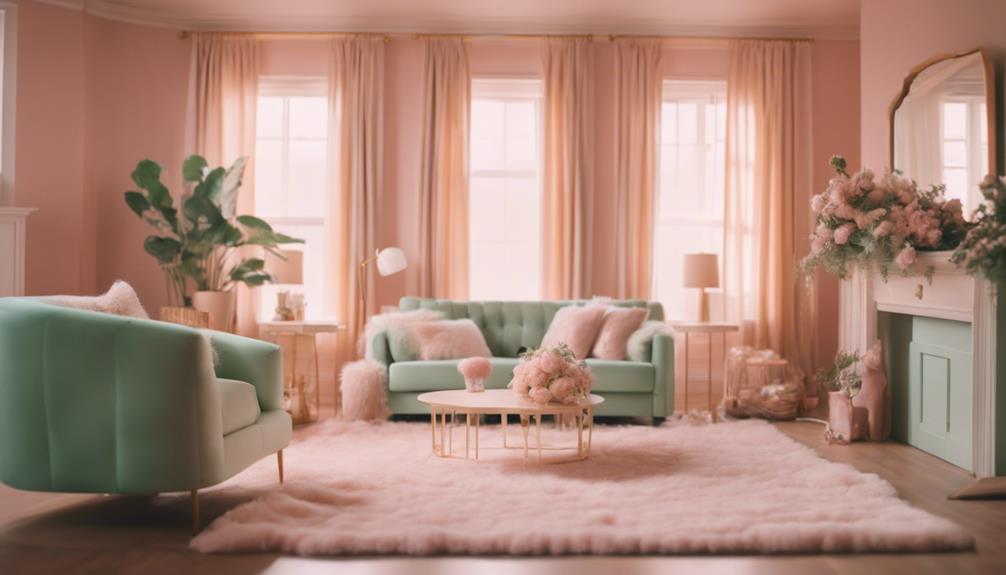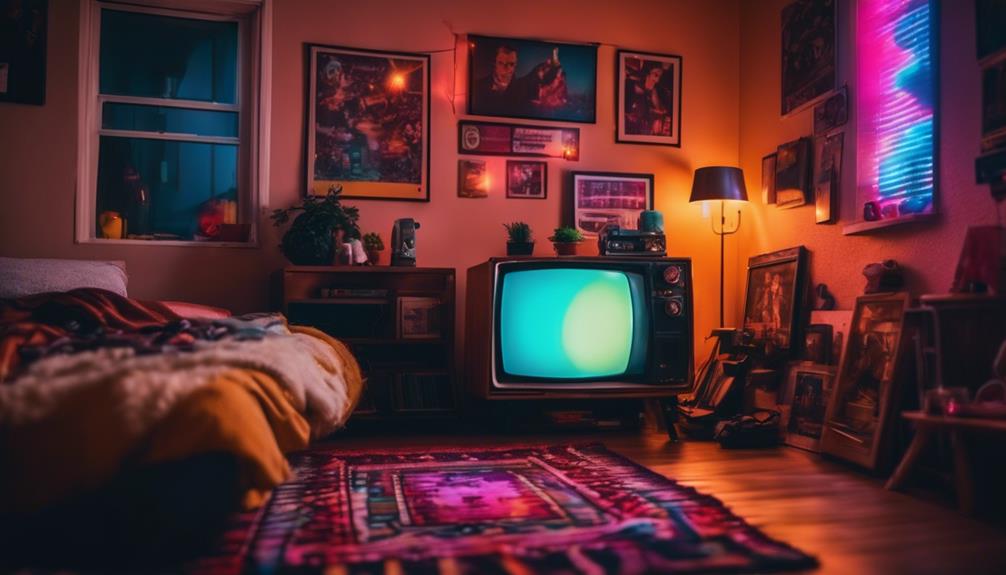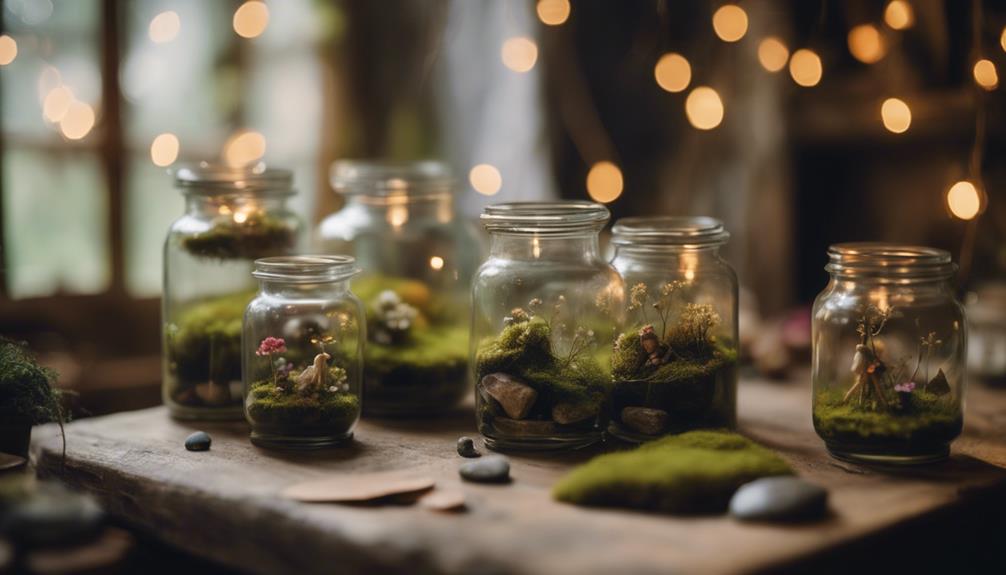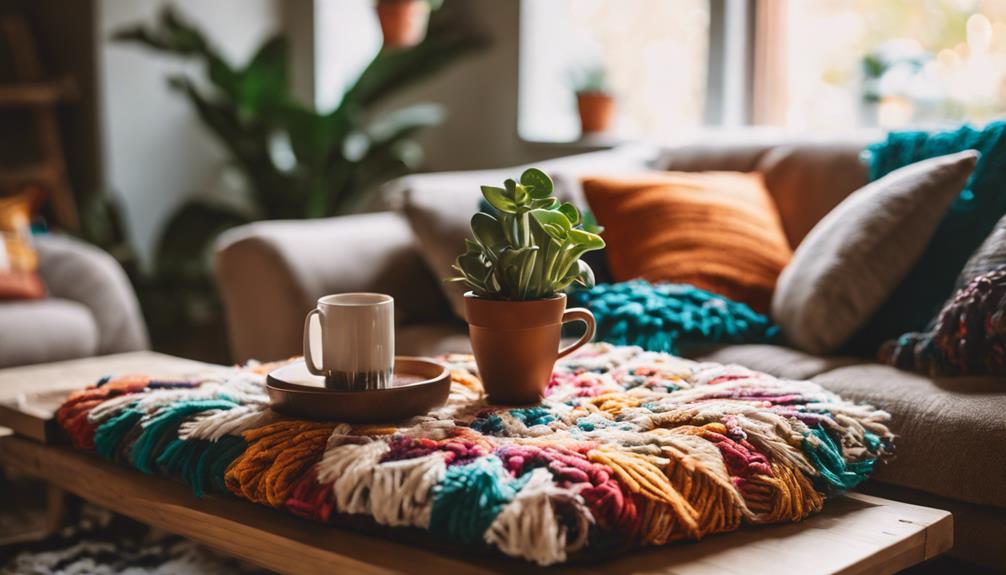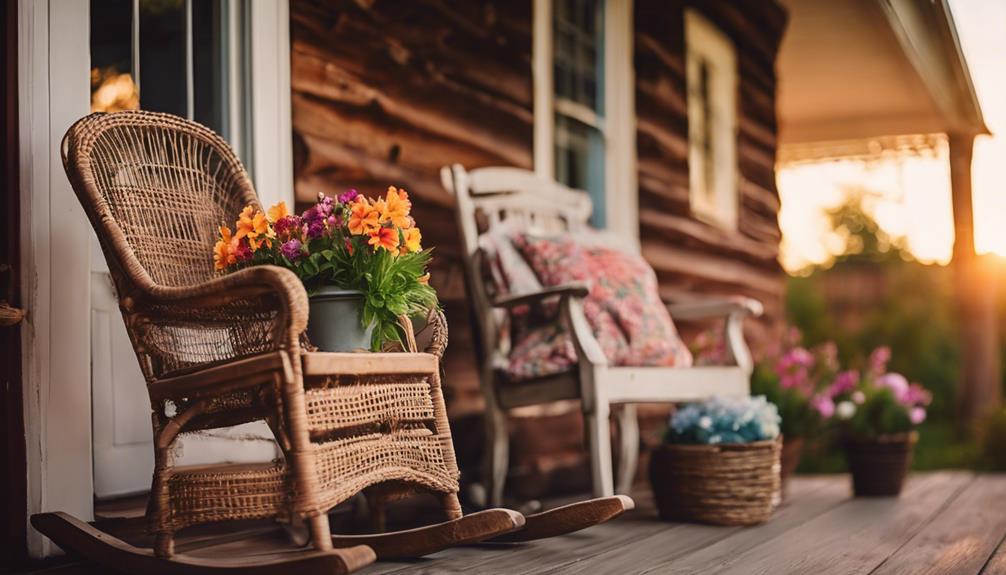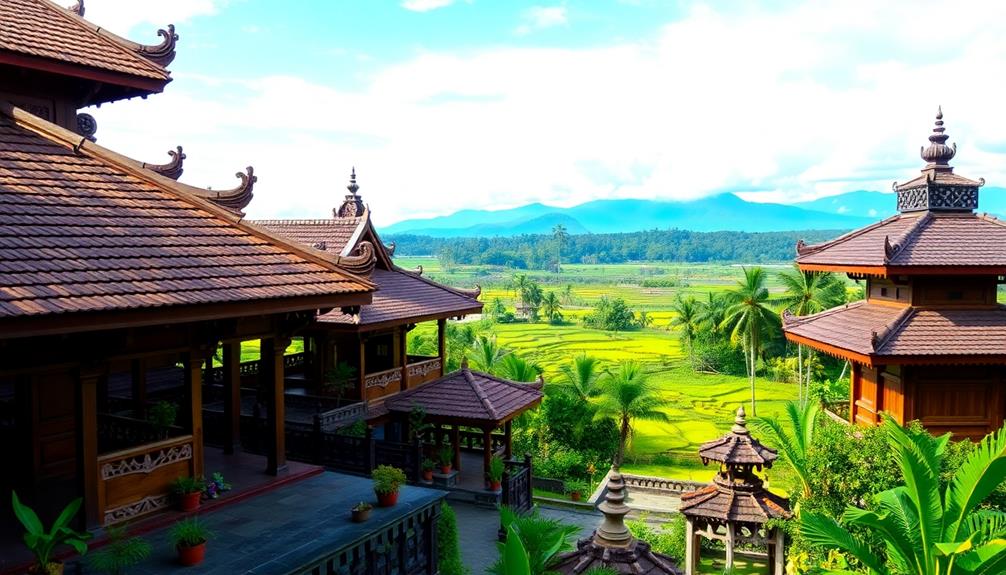Pastel room decor brings a soothing vibe to your space, using soft colors like blush pink, lavender, and mint green. You can incorporate plush cushions and cozy throws for a tactile experience. Consider pastel furniture pieces, such as a curvy checker sofa, to serve as a stylish centerpiece. Enhance the atmosphere with lighting options like pastel pendant lights or fairy lights, which create a warm glow. Don't forget decorative elements like wall art or patterned rugs to tie the look together. There's so much more to explore, so let's discover additional ideas to elevate your pastel decor!
Key Elements
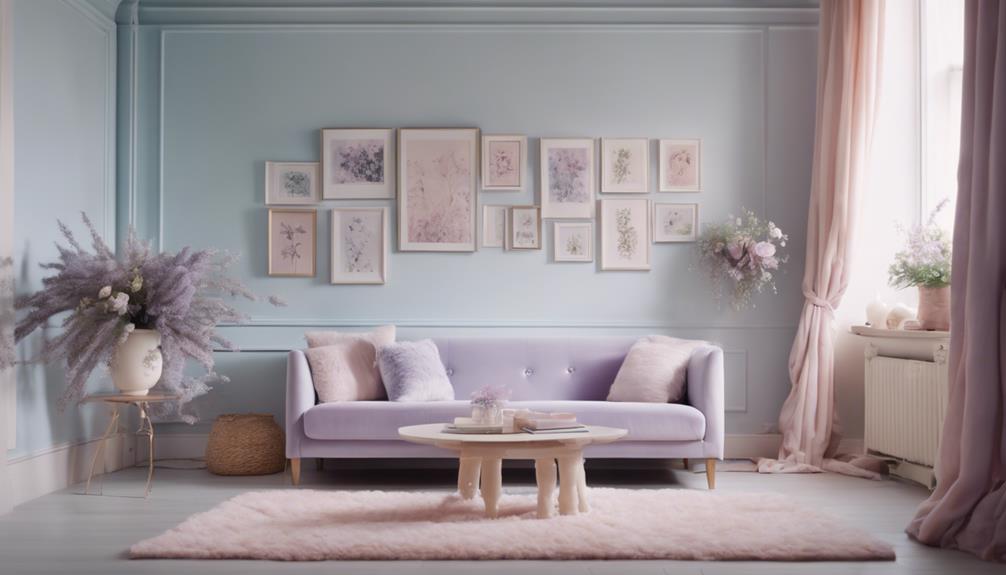
When creating your pastel room, focus on the color scheme, materials, and textures that will bring your vision to life.
Choosing the right pastel hues and pairing them with complementary materials can enhance the overall vibe of your space.
Think about how different textures can add depth and interest, making your room feel both cozy and stylish.
Color Scheme
A pastel color scheme features soft shades like blush pink, pale blue, mint green, and lavender, creating a calming atmosphere that's perfect for any room. These gentle hues enhance the overall aesthetic, promoting relaxation and reducing stress in your space. By incorporating pastel decor elements such as cushions, throws, and wall art, you not only add visual interest but also contribute to a cohesive decor theme.
Mixing pastel colors with neutral tones helps maintain balance and harmony, ensuring your room feels inviting and comfortable. Using pastel wall colors can greatly enhance the perception of natural light, making your space feel more open and airy. This interaction between soft shades and light creates a serene environment that's perfect for unwinding after a long day.
To maximize the calming environment, focus on layering different pastel tones. For example, pairing a pale blue sofa with blush pink cushions creates a delightful contrast while still feeling harmonious. The key is to select shades that resonate with your personal style, allowing you to craft a space that's uniquely yours while embracing the soothing essence of pastel decor.
Materials
Incorporating soft textiles like cotton and fleece creates a cozy atmosphere that enhances your pastel room decor. Start with pastel bedding in gradient shades, which not only offers comfort but also elevates the overall aesthetic. You can find sets priced between $54.99 and $99.99, making it easy to find something that fits your budget.
To add a splash of color, consider decorative pillows and cushions, like the Plush Daisy Flower Pillow available for $19.99. These not only boost comfort but also inject vibrant pastel hues into your space.
Canvas wall art featuring pastel themes, priced from $9.99, contributes to a serene and visually appealing environment. Pair these with pastel rugs, such as the Pastel Blob Irregular Accent Rug for $49.99, to provide both style and comfort underfoot.
Textures
Using a mix of textures, like fluffy rugs and soft throws, makes your pastel room feel more inviting and cozy. To achieve that perfect pastel aesthetic, consider layering different elements.
Start with soft bedding crafted from cotton, which provides both comfort and style. Add plush cushions in various fabrics to create a tactile experience that invites relaxation.
Incorporate smooth surfaces from pastel furniture, as their curved lines enhance the room's softness while maintaining visual interest. Textured accessories, like wavy ceramic vases and swirly candles, bring depth to your decor without disrupting the cohesive look. These pieces not only serve as decorative accents but also contribute to the overall cozy atmosphere.
Don't shy away from mixing textures; combining knits or soft throws with your pastel decor amplifies the serene and calming environment you're aiming for. By thoughtfully layering these elements, you create a space that feels both warm and aesthetically pleasing.
Essential Fixtures and Furniture
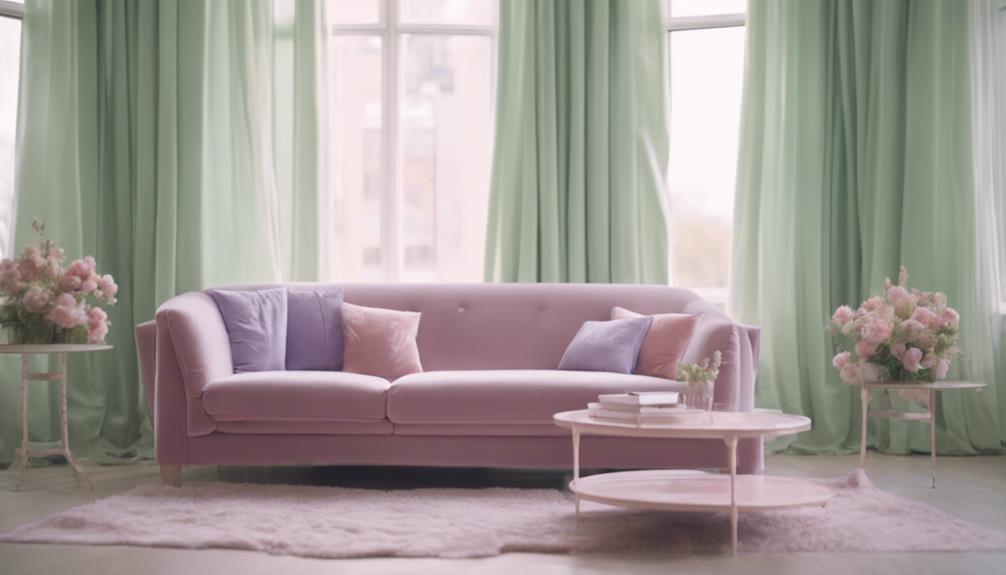
When you're setting up your pastel-themed room, choosing the right fixtures and furniture is key.
A Tufted Daisy Flower Accent Rug adds both comfort and style, while a Pastel Curvy Checker Sofa can serve as a stunning centerpiece.
Together, these pieces create a harmonious and inviting atmosphere that highlights your pastel decor.
Tufted Daisy Flower Accent Rug
The Tufted Daisy Flower Accent Rug, priced at $44.99, adds a playful and whimsical touch to your pastel-themed room while enhancing comfort and durability.
Available in multiple pastel colors like pink, yellow, blue, and green, this rug serves as a versatile addition that fits seamlessly into your decor. The unique daisy design elevates the aesthetic, creating a soft and calming environment.
Crafted from high-quality materials, the tufted construction guarantees you get both comfort and durability, making it perfect for high-traffic areas in your home. Imagine sinking your feet into its soft texture, which not only adds visual appeal but also enhances your space's overall comfort.
You can use the tufted daisy flower accent rug as a focal point, drawing attention to your decor while complementing other pastel items. This approach helps you achieve a cohesive look in spaces such as bedrooms or living rooms.
Ultimately, this rug is more than just a decorative piece; it's a way to create a serene atmosphere that invites relaxation and joy into your home.
Pastel Curvy Checker Sofa
Elevate your living space with the Pastel Curvy Checker Sofa, a stylish centerpiece that seamlessly blends comfort and modern design.
This unique sofa boasts soft pastel colors, making it an ideal choice for those who embrace the pastel aesthetic. Priced at approximately $499.99, it combines functionality and aesthetic appeal, perfect for transforming your modern living spaces.
The curvy shape of the Pastel Curvy Checker Sofa not only enhances comfort but also adds a playful touch to any room. Its design aligns beautifully with both minimalist and eclectic styles, allowing you to pair it with various pastel decor items for a cohesive atmosphere.
Whether you're hosting friends or enjoying a quiet evening, this sofa creates a serene backdrop.
Durability is another highlight of the Pastel Curvy Checker Sofa. Crafted from high-quality materials, it maintains its soft, inviting look over time, ensuring you enjoy its charm for years to come.
Pastel Curvy Checker Sofa
Incorporating the Pastel Curvy Checker Sofa into your space not only enhances its aesthetic but also highlights the importance of choosing the right essential fixtures and furniture to complement your decor.
This stunning sofa, featuring soft pastel colors, serves as a perfect centerpiece for any pastel-themed living area. Priced from $499.99, it combines style and functionality effortlessly.
The unique curvy checker pattern adds visual interest and texture, making it a true statement piece that aligns with contemporary decor trends. Its plush design guarantees comfort while maintaining a chic look, ideal for everyday seating. Constructed with durable materials, this sofa promises longevity without sacrificing its inviting appearance.
What's more, the versatile design allows the Curvy Checker Sofa to blend seamlessly with other pastel decor elements, enhancing the serene and calming atmosphere of your room.
Whether you're hosting friends or enjoying a quiet night in, this sofa elevates your space and makes a lasting impression. So, if you're looking to create a soft, aesthetic vibe in your home, the Pastel Curvy Checker Sofa is an essential addition you won't want to overlook.
Lighting Ideas
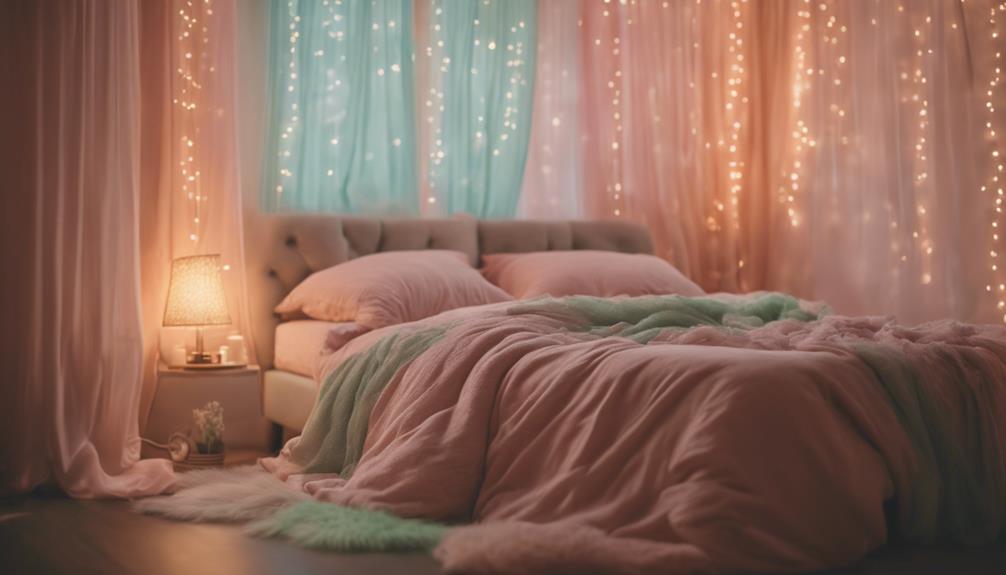
When it comes to lighting, you'll want to choose fixtures that enhance your pastel decor while providing the right ambiance.
Consider options like a pastel pendant light fixture or charming wall sconces to bring character to your space.
Adding touches like pastel neon tube lights or string fairy lights can create a cozy atmosphere and elevate your room's overall aesthetic.
Pastel Pendant Light Fixture
Pastel pendant light fixtures add a charming touch to your decor, offering both functional illumination and a stylish focal point in any room. Available in soft hues like blush pink, mint green, and pale blue, these lights enhance the calming atmosphere of your space. They serve not only as decorative focal points but also complement your pastel-themed decor beautifully.
When you choose a pastel pendant light, look for unique shapes, such as geometric or organic forms, which can introduce visual interest and a modern flair to your interiors. The right fixture can elevate your room, reflecting light beautifully off pastel walls and furnishings, creating a serene ambiance that invites relaxation.
Remember to reflect on the brightness and type of bulb used. Opting for soft lighting can enhance the overall pastel aesthetic without overwhelming your space.
Whether you hang a single pastel pendant light or create a cluster of them, you'll find that they're an ideal choice for adding both style and warmth to your home. Embrace the charm of pastel pendant light fixtures, and transform your room into a haven of tranquility and elegance.
Pastel Wall Sconce Lighting
Often overlooked, pastel wall sconce lighting can beautifully enhance your room's aesthetic while providing soft, inviting illumination. By incorporating pastel wall sconces, like the stylish Glass Spiral Striped Lamp priced at $49.99, you create a calming atmosphere that complements your pastel decor elements. These fixtures serve as both decorative accents and functional lighting, ensuring your space feels warm and welcoming.
Pastel lighting solutions, such as the Fairy Shell Pearl Night Lamp at $44.90, further add to this soothing ambiance. Their soft pastel shades reflect natural light, enhancing the lightness and serenity characteristic of pastel decor. Strategically placing these sconces can help create focal points in your room, drawing attention to specific areas while maintaining a cohesive look.
When combined with other pastel decor elements, pastel wall sconces can transform your space into a peaceful retreat. Whether you're reading a book, enjoying a quiet evening, or entertaining friends, the gentle glow from these fixtures sets the perfect mood.
Embrace the beauty of pastel wall sconce lighting to elevate your room's aesthetic and cultivate a serene environment you'll love spending time in.
Pastel Neon Tube Light
Incorporating pastel neon tube lights into your decor brings a modern flair that perfectly complements the soft ambiance created by pastel wall sconces. These vibrant lights enhance the overall aesthetic of your space, providing a gentle glow that aligns beautifully with your pastel decor. Available in colors like pastel pink, blue, and green, they add a lively yet calming touch to your cozy living spaces.
Pastel neon tube lights are incredibly versatile; you can use them as wall accents, under-shelf lighting, or even as standalone decor pieces. Their soft illumination promotes relaxation, making them ideal for bedrooms or any area where you unwind.
Plus, many of these lights come with adjustable brightness settings, allowing you to create the perfect atmosphere for any occasion—be it a cozy movie night or a lively gathering with friends.
Pastel String Fairy Lights
Transform your space with pastel string fairy lights that create a whimsical and inviting ambiance, perfect for enhancing the calming atmosphere of any pastel-themed room. Available in soft colors like pink, blue, and lavender, these lights serve as beautiful decorative accents that can be easily incorporated into your decor.
You can drape them over furniture, wrap them around windows, or even hang them on walls to achieve that enchanting look. Many pastel string fairy lights utilize LED technology, ensuring you get energy-efficient lighting without compromising on that dreamy glow.
The flexibility in lengths and styles allows you to customize the setup to fit any area, whether it's a cozy bedroom or a vibrant living room. By incorporating pastel string fairy lights, you're not just elevating your decor; you're also promoting relaxation and tranquility in your home.
The gentle illumination offers a soothing effect, making it an ideal choice for unwinding after a long day.
Decorative Elements
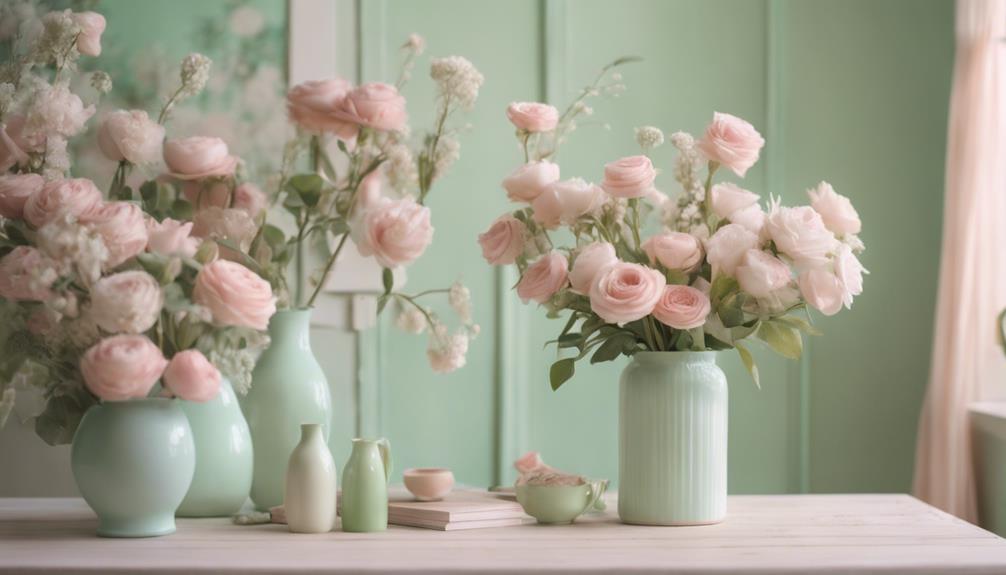
When it comes to decorative elements in a pastel-themed room, you'll want to choose items that bring color and personality.
Consider adding a Pastel Flower Throw Pillow for a pop of softness, a Pastel Geometric Wall Hanging for modern flair, or a Pastel Rainbow Wall Tapestry to create a cheerful focal point.
These accents not only enhance your decor but also tie the entire look together beautifully.
Pastel Flower Throw Pillow
The Pastel Flower Throw Pillow, priced at just $21.99, adds a touch of cozy elegance to your pastel-themed room. This decorative accent features soft pastel colors that beautifully enhance the overall aesthetic, making it a perfect addition for those who appreciate minimalist decor. Whether you place it on your sofa or bed, it instantly elevates your space while maintaining a serene environment.
Customer feedback highlights the pillow's comfort and design, with multiple reviews praising its ability to create a cozy atmosphere. The soft pastel colors not only complement various decor styles but also encourage a calming vibe, which is essential for any relaxing space. By incorporating the Pastel Flower Throw Pillow, you can easily refresh your decor without overwhelming your room.
This pillow serves as a delightful focal point, harmonizing with other pastel elements in your decor. Its affordable price makes it accessible for anyone looking to add a touch of charm and comfort.
Pastel Geometric Wall Hanging
Pastel geometric wall hangings add a modern touch to your decor with their soft colors and unique shapes. These decorative elements seamlessly blend into any room, enhancing the overall ambiance while maintaining a calming aesthetic.
You'll find them available in various pastel shades like blush pink, mint green, and pale blue, making it easy to coordinate with your existing decor themes. The modern designs of pastel geometric wall hangings often feature a combination of shapes that create visual interest without overwhelming your space.
They serve as striking focal points, drawing attention and creating a sense of harmony in a pastel-themed room. Plus, many of these wall hangings are crafted from lightweight materials, making installation a breeze.
You can hang them in clusters or place a single piece above a bed or sofa for a chic statement. Whichever way you choose to display them, pastel geometric wall hangings will certainly elevate your decor game.
Embrace their soft colors and modern designs to create a serene and stylish atmosphere that reflects your personal taste.
Pastel Rainbow Wall Tapestry
Adding a Pastel Rainbow Wall Tapestry brings a cheerful and playful element to your decor, perfectly complementing the modern vibe created by geometric wall hangings.
This tapestry features a soft color palette that enhances your pastel-themed decor, instantly brightening any room. Priced at just $34, it's an affordable decorative option that won't break the bank while making a significant impact.
Ideal for creating a focal point, the Pastel Rainbow Wall Tapestry can be easily hung on any wall, transforming the ambiance of your space. Its vibrant yet soothing colors promote a calming atmosphere, aligning beautifully with the overall benefits of pastel decor.
The lightweight fabric guarantees that installation and removal are a breeze, allowing you to easily switch up your decor for different seasons or moods.
Whether you're looking to refresh a bedroom, living room, or any other area, this tapestry serves as a versatile choice that adds both charm and elegance.
With its playful design and calming hues, you'll find that the Pastel Rainbow Wall Tapestry is a delightful addition to your home.
Flooring
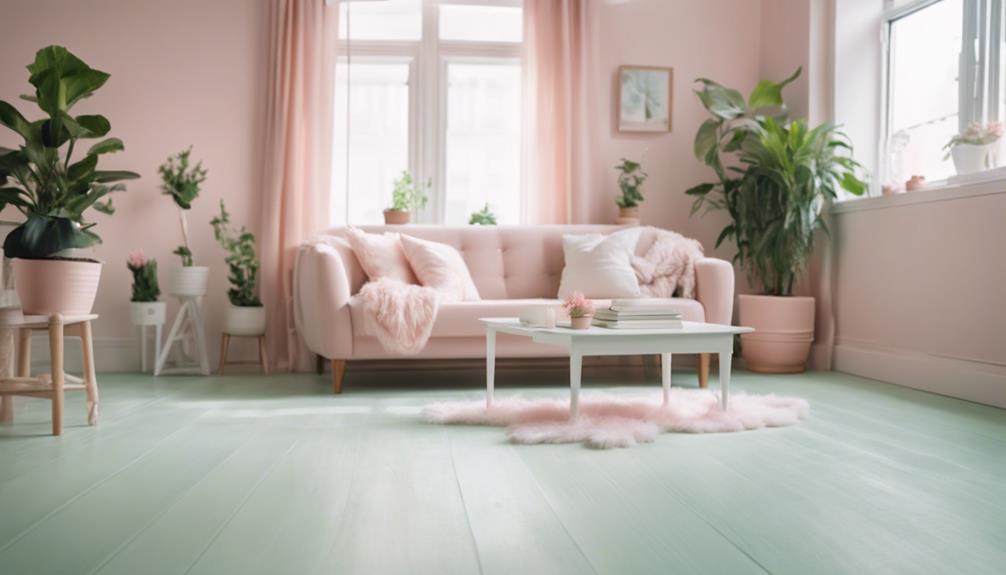
When choosing flooring for your pastel-themed room, consider options like pastel herringbone patterned laminate or playful pastel polka dot vinyl.
These choices not only enhance the aesthetic but also provide a unique foundation for your decor.
Adding a soft, textured area rug can bring warmth and comfort, tying the look together beautifully.
Pastel Herringbone Patterned Laminate
Transform your space with herringbone-patterned laminate flooring in soothing pastel shades that effortlessly elevate your room's aesthetic.
Picture your floors adorned with lovely blush pink, light blue, or mint green hues, creating a versatile backdrop for your aesthetic decor. The classic herringbone design adds depth and visual interest, making it a perfect fit for pastel-themed spaces.
Not only does pastel herringbone laminate flooring enhance your decor, but it's also durable and easy to maintain. This makes it a smart choice for high-traffic areas, ensuring your floors look great even in bustling environments. You'll love how it promotes a calming ambiance, helping to create a serene atmosphere in your home.
One of the best features of this flooring is its straightforward installation. With a user-friendly click-lock system, you can tackle the project as a DIY enthusiast, transforming your space without the need for professional help.
Pastel Polka Dot Vinyl Flooring
Looking for a fun and cheerful flooring option? Pastel polka dot vinyl flooring brings a playful design to your space with its light hues like soft pink, mint green, and pale blue. This flooring not only enhances the aesthetic appeal of your home, but it also creates a cheerful atmosphere that invites positivity and joy.
One of the best features of pastel polka dot vinyl flooring is its durability. It's designed to withstand high-traffic areas, ensuring that your floors maintain their beauty over time. Plus, it's water-resistant, making it a great choice for kitchens and bathrooms where spills are common.
This flooring option seamlessly complements various pastel decor styles, allowing you to create a cohesive look throughout your home. Whether you're going for a whimsical vibe or a more sophisticated pastel theme, the polka dot pattern adds just the right touch of charm.
Available in various sizes and thicknesses, you can easily customize your pastel polka dot vinyl flooring to fit any room layout. It's a practical and stylish choice for anyone looking to elevate their space with a soft, playful touch.
Pastel Textured Area Rug
Pastel textured area rugs add a layer of comfort and style to your space, perfectly complementing the cheerful vibe established by pastel polka dot vinyl flooring. These rugs come in a variety of designs and colors, such as the Pastel Blob Irregular Accent Rug for $49.99, which features vibrant hues like green, purple, and pink, adding a playful touch to any room.
If you're looking for something more inviting, the Tufted Daisy Flower Accent Rug at $44.99 showcases pastel shades of pink, yellow, blue, and green, creating a cheerful atmosphere. For a unique flair, consider the Curvy Edge Pastel Checker Rug available for $49.99, enhancing both comfort and style with its multiple pastel shades.
Textured area rugs not only soften the look of a room but also provide a cozy feel underfoot, contributing to the calming aesthetic of pastel decor.
How Can I Combine Aesthetic Room Decor With Pastel Room Decor for a Soft and Stylish Space?
Combine soft pastel room decor styling for a stylish and soothing space. Use pastel colors like blush, mint, and lavender for a calming ambiance. Incorporate aesthetic room decor elements like minimalist furniture, fluffy rugs, and elegant wall art to create a soft and chic atmosphere that promotes relaxation and tranquility.
Conclusion
Incorporating pastel room decor can transform your space into a soothing oasis.
By focusing on key elements like essential fixtures, lighting, and decorative touches, you can create a harmonious atmosphere that reflects your style.
Don't forget about the flooring, as it plays a vital role in tying the whole look together.
Embrace these soft and aesthetic ideas, and you'll soon enjoy a beautifully curated room that feels both inviting and uniquely yours!
